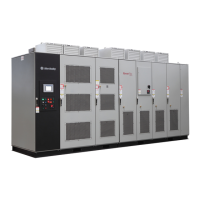Rockwell Automation Publication 6000-UM002E-EN-P - April 2018 89
Preventative Maintenance and Component Replacement Chapter 5
Medium Voltage Motor control equipment should be inspected periodically.
Inspection intervals should be based on environmental and operating conditions
and adjusted as indicated by experience. An initial comprehensive inspection,
within 3 to 4 months after installation, is suggested. Refer to the following
standards for general guidelines for setting-up a periodic maintenance
program.For countries following NEMA standards, refer to National Electrical
Manufacturers Association (NEMA) Standard No. ICS 1.1 (Safety Guidelines
for the Application, Installation, and Maintenance of Solid-Sate Control) for
MV Drives and ICS 1.3 (Preventive Maintenance of Industrial Control and
Systems Equipment) for MV Controllers. For countries following IEC standards,
refer to IEC 61800-5-1 Sec. 6.5 for MV Drives and IEC 60470 Sec. 10, IEC
62271-1 Sec. 10.4 for MV Controllers.
The maintenance work for the PowerFlex 6000 drive should normally be
performed on a yearly cycle. This work is carried out by Rockwell Automation
medium voltage drive customers. The customer may extend the maintenance
interval appropriately according to the installation conditions and operating
conditions of the drive. Determine the maintenance cycle and component/items
according to the customer site application. The purpose of performing annual
maintenance is to locate potential failures and take preventive measures before a
real failure occurs. Therefore it is recommended to spend about 16 hours to
perform annual maintenance to ensure that the drive is functioning reliably. This
can greatly reduce the risk of unplanned downtime.
Before starting preventive maintenance, you should record some important
information, including:
1. Report of the previous preventive maintenance (if any).
2. Get motor parameters and applications.
3. Check the current settings of the drive.
4. Check the fault/warning queue.
5. Save parameters to a recipe file
(1)
or parameter record.
6. Record the board part number, serial number, and edition.
(2)
If inspection reveals that dust, dirt, moisture or other contamination has reached
the control equipment, the cause must be eliminated. This could indicate
unsealed enclosure openings (conduit or other) or incorrect operating
procedures. Replace any damaged or embrittled seals, and repair or replace any
other damaged or malfunctioning parts. Replace dirty, wet, or contaminated
control devices unless they can be cleaned effectively by vacuuming or wiping.
(1) For devices with recipe function options.
(2) Records are required only if spare parts replacement is replaced after preventive maintenance activities.
Compressed air is not recommended for cleaning because it may displace dirt,
dust, or debris into other parts or equipment, or damage delicate parts.

